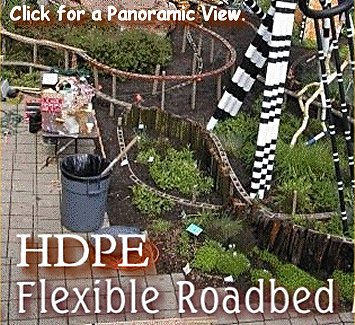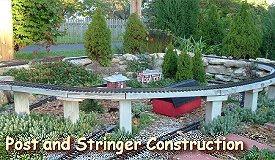 | |||
Family Garden Trains, click on any link below: | |||

|  |  | |
 |  | ||
 |  | ||
 |  | ||
 |  | ||
Written by Paul D. Race for Family Garden Trains(tm)

 | |||
Family Garden Trains, click on any link below: | |||

|  |  | |
 |  | ||
 |  | ||
 |  | ||
 |  | ||
Written by Paul D. Race for Family Garden Trains(tm)

 | HDPE Flexible RoadbedBy Paul Race (with major input by Bill Logan)Part 1Paul speaking: About 2002, a Columbus-area architect named Bill Logan began developing a construction method for raised roadbed that:
In 2002, Bill was on the committee to design a public display layout for the Franklin Conservatory in Columbus. With his architectural background and love for engineering challenges, he wanted to find a better way to install raised roadbed than the "tried and true" post-and-stringer method most garden railroaders - including professional installers - had been using the 1980s. After some engineering calculations and some trial and error, Bill came up with a simple process almost anyone should be able to use to create smooth, strong roadbed that conforms to any reasonable curve (and some unreasonable ones, if you ask me). Bill gave me constant input as I put this article together, including several passages that I will try to annotate. The construction ideas are all Bill's; my contribution was to communicate Bill's ideas in a way most people can understand. Update for 2006Since Bill helped me put this article together, I am aware of dozens of other railroads that have been constructed this way. No one has reported a serious problem, and many people have reported their delight with the finished product. Bill has himself has advised several homeowners and at least one shopping center on building beautiful, complex railroads that use this method. (If you ever get to the Columbus, Ohio area, check out the "Easton Express" at the Easton Town Center, not far from Columbus' airport.)In March, 2006, I reformatted this article to make it easier to read, and I made many minor changes and corrections. I also added two photos of "test runs" on the Franklin Conservatory project. I hope soon to add example and construction photos from other projects to give readers a different perspectives on some of the tasks involved, so stay tuned. Please let me know if you need any additional information or note any additional changes that should be made. Thanks in advance - Paul |
What Bill Came Up With When Bill started his research, most raised garden railroads used post-and-stringer construction that consisted mostly of 2x6 pressure-treated lumber fastened on 4x4 posts. Although Bill was dissatisfied with the amount of waste you get from using 2x6"s, he was more "put off" by the appearance of the 2x6"s on the "finished" product.
Specifically, Bill didn't like the way they jutted out beyond the tie width, or the fact that they are solid when viewed from above, which makes them look silly when you try to disguise them as bridges or trestles. When Bill started his research, most raised garden railroads used post-and-stringer construction that consisted mostly of 2x6 pressure-treated lumber fastened on 4x4 posts. Although Bill was dissatisfied with the amount of waste you get from using 2x6"s, he was more "put off" by the appearance of the 2x6"s on the "finished" product.
Specifically, Bill didn't like the way they jutted out beyond the tie width, or the fact that they are solid when viewed from above, which makes them look silly when you try to disguise them as bridges or trestles.
While Bill was concerned with structural integrity, he also knew that he would be working with many non-carpenters on the Franklin Park project. He wanted a method that small teams without a master carpenter could implement consistently throughout the project. The system Bill developed could be called "open stringer;" it still uses posts and stringers, but the finished installation looks far more "open" from above. In fact, the roadbed looks something like flexible "ladders" for which the "rails" and "rungs" are prepared in the "shop" and assembled to fit onsite. |
Tools needed:
Materials needed:
One nice aspect is that all the ripping and part of the reassembly can be done in a comfortable dry workshop months ahead of the actual track-laying. |
Bill's General Comments
|

| 
|
 |
 |
 |
 |
 |
Note: Family Garden Trains?, Garden Train Store?, Big Christmas Trains?, BIG Indoor Trains?, and BIG Train Store? are trademarks of Breakthrough Communications (www.btcomm.com). All information, data, text, and illustrations on this web site are Copyright (c) 1999, 2000, 2001, 2002, 2003, 2004, 2005, 2006, 2007, 2008, 2009, 2010, 2011, 2012, 2013 by Paul D. Race. Reuse or republication without prior written permission is specifically
forbidden.
Family Garden Trains is a participant in the Amazon Services LLC Associates Program, an affiliate advertising program designed to provide a means for sites to earn advertising fees by advertising and linking to amazon.com.
For more information, please contact us

 |  |